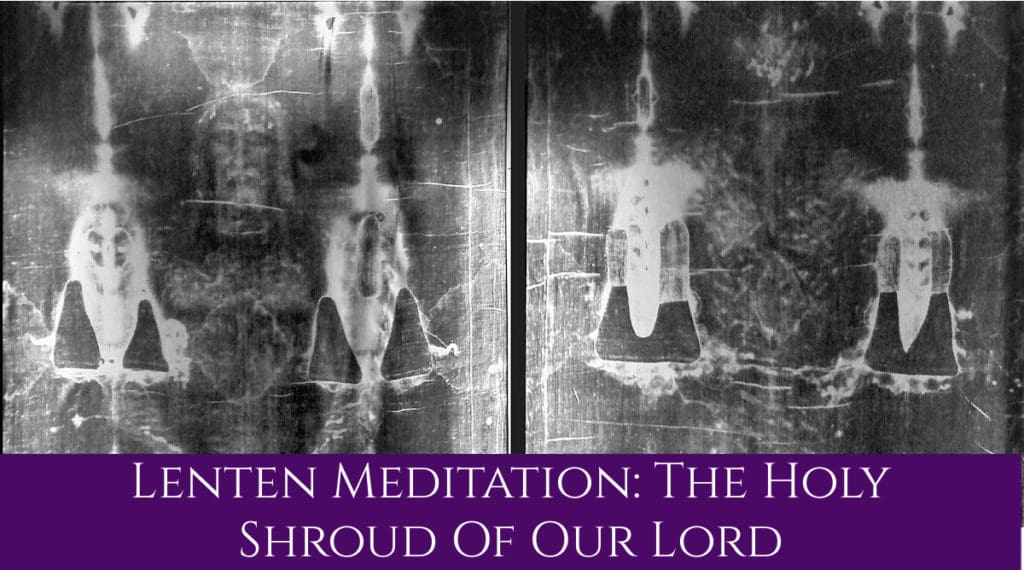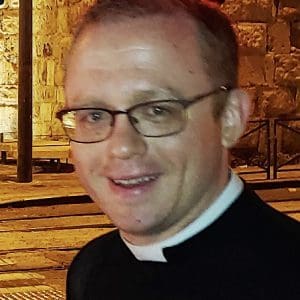Authors Introduction: This is the third of a series of meditations based on the Lenten Votive Masses of the Passion of Jesus that have been prayed throughout the history of the Church in various usages. Some have their origin in early medieval times and were used in various places in Europe and in particular religious orders. Some can be found in the 1955 and 1962 editions of the Missale Romanum. Some parallel prayers can be found in the current English edition of the Roman Missal as well as the Missal of the Holy Land. These meditations are given to offer us an old yet new way to enter into the Passion of Jesus and the salvation He offers us that is rooted in scripture, tradition, and history of the Church. May praying with and reflecting on them help you to grow in Divine Intimacy with Our Lord Jesus and His saving graces this Lenten season and whenever you enter into prayer.
This was given as a meditation during a Lenten Forty Hours Devotion on Saturday, March 12, 2022, at Saint Mary’s Church, Washingtonville, New York.
The scripture readings and text of the prayers of this mass can be found here.
Opening Collect: O God, Who has left us the traces of Thy passion with the holy Shroud wherein Thy most Sacred body, taken down from the cross, was wrapped by Joseph, mercifully grant that by Thy death and burial we may be brought to the glory of thy resurrection.
When one goes up to the Chapel of Golgotha in the Church of the Holy Sepulchre in Jerusalem, one sees a very interesting Greek Orthodox altar to the far left of the altar that marks the spot where Our Lord Jesus was crucified. At this altar, one can see a Greek icon of the Nativity at its top. It depicts the Blessed Virgin Mary, Saint Joseph, and the angels in humble adoration of the baby Jesus, wrapped in swaddling clothes, resting in the manger with the light of the star of Bethlehem glistening down upon his face and body.
Beneath this icon, at the very center of this altar, we see another icon depicting Our Lord Jesus crucified, dead, and his broken body taken down from the cross. He is held in the Blessed Virgin Mary’s arms for the last time, wrapped in his burial shroud by Joseph of Arimathea, Saint John the Beloved, and the other remaining disciples. Mary holds her son, and Saint John kisses his Rabbi, Lord, and Master’s crucified hand as they prepare to place his body in the tomb (Gospel of the Mass – Mark 15:42-56). Jesus, in His humanity, comes into the world in the joyous, peaceful, hidden light of a star. He who is the one true God, Light of the World, Messiah, Son of God, and Son of Man enters this world as a humble small baby boy humble and lovingly obedient to the Father’s will. Now in the darkness of his passion, he leaves this world just as he entered it, humble, obedient to the Father’s will to the end. In both moments, he is looked upon with love by his Mother. Our Lady keeps the mysteries of salvation unfolding around her both in joy and in sorrow with the utmost reverence, pondering them in her heart even as she is pierced with a sword of agony. At this action, the prophecy that Isaiah once said of the Suffering Servant is now fulfilled: “Who is he that comes from Edom, in crimsoned garments, from Bozrah? Who is this, glorious in his apparel, striding in the greatness of his strength? “It is I, I who announce vindication, mighty to save.” Why is your apparel red, and your garments like one who treads the winepress? The wine press I have trodden alone, and from the peoples no one was with me. I trod them in my anger, and trampled them down in my wrath; Their blood spurted on my garments, all my apparel I stained. For a day of vindication was in my heart; my year for redeeming had come. (Lesson of the Mass – Isaiah 63:1-4)
Jesus, who was betrayed by Judas, who was unjustly put to death by our sinfulness, by that same death conquers sin, death, and Satan through love. He, whose burial cloth is seen by the eyes of the world as a sign of death and defeat, now transforms this same cloth stained with his own sweat and blood into a royal banner of victory.
The Light of the World, the King of kings, now enclosed in the darkness of death and the tomb still shines forth the light of redemption for all who accept it by his humble surrender to the Father’s will as his body lays wrapped in his burial cloth in the tomb. The trustful surrender and humble obedience of Jesus to the will of the Father is how he defeats evil, sin, death, and wins our salvation. The burial cloth of Jesus would come into the custody of the Cathedral of Turin, Italy, and later become a relic of the passion that would receive significant veneration throughout the Christian world.
Connected to this side altar depicting the wrapping of the newborn baby Jesus in swaddling clothes at the manger in Bethlehem as well as his wrapping in his burial shroud at the foot of the cross is a giant stone slab found at the entrance to the Church of the Holy Sepulchre. This is where Jesus’ body lay prostrate after his death and removal from the cross and before it was placed in the tomb. It was also the place where his body was held for the last time on earth by His mother Mary while the other disciples wrapped it in the burial shroud. The posture of prostration is done by deacons, priests, and bishops on the day of their ordination as well as by religious men and women on the day of solemn profession of vows. Prostration is also a posture of the heart that husbands and wives embrace with their “I do’s,” in their exchange of vows when they enter the Sacrament of Matrimony together. Jesus prostrated himself in prayer in his agony in the Garden of Gethsemane at the start of his passion. He again repeats this action at the close of His passion by his death in loving obedience to the Father’s will at the time of his burial.
The gesture of physical prostration implies a total surrender and letting go in a way that does not subjugate and repress. It represents a loving, free gift of self, an offering of one’s entire life, will, and experiences to God. This physical dimension of prostration is symbolic of a movement of the heart that all the baptized owe unto God out of justice and love. The act of prostration speaks to the reality that my entire person is made and defined by the love and worship of the Holy Trinity, the one true God. It also represents that in a life of faith and even in my death, I belong completely to God and that I never live purely for myself. Love and worship is unified in the gesture of prostration and they imply a particular order rooted in truth and obedience. Obedience to truth does not shackle me and lessen my freedom but rather enables me to receive more from God by his grace than I can by my own power and ability.
Jesus echoes these internal dispositions of worship of the Father through the Spirit and the surrender of all he has to him in the depths of his Sacred Heart just before he dies on the cross. He echoes this disposition in his final words, “Father into your hands, I commend my spirit” (Lk 23:46), which he will echo in his body by its prostration on the burial slab in his death and burial. Saint John of the Cross speaks of the same prostration in the prayer of faith with the surrender of all that we are to God:
People must be emptied of all such things, insofar as they can, so that however many supernatural experiences they may receive, they will continually live as though denuded of them and in darkness. Like the blind, they must lean on dark faith, accept it for guide and light, and rest upon none of the things of what they understand, experience, feel, and imagine. All these perceptions are darkness that will lead them astray. Faith lies beyond all this understanding, taste, feeling, and imagining. If they do not blind themselves in these things and abide in total darkness, they will not reach what is greater: the teaching of faith. (Ascent of Mount Carmel 2.4.2).
This way of denuding and surrender that John speaks about is that stripping of our hearts to receive the complete indwelling of the love of God. It mirrors the total self-gift that Jesus began when he was a child in swaddling clothes in the manger in Bethlehem. It is also mirrored in his final gift of self with his death on the cross, wrapping in burial cloth and the placing of his body in the tomb. This grace of surrender and its disposition of vulnerability is what strips us of our former sinful self and enables us to perceive, love, and live in the new life of the Resurrection. This self-surrender is reminiscent of the young child learning from his parents, learning how to go beyond his own impulses and impositions to finally learn how to walk rightly. The soon-to-be-saint Charles de Foucald also speaks of the reality of self-surrender in prayer, its character of worship, and the disposition of freedom that God gives us through it by his famous Prayer of Abandonment:
Father,
I abandon myself into your hands;
do with me what you will.
Whatever you may do, I thank you:
I am ready for all, I accept all.
Let only your will be done in me,
and in all your creatures –
I wish no more than this, O Lord.
Into your hands I commend my soul:
I offer it to you with all the love of my heart,
for I love you, Lord, and so need to give myself,
to surrender myself into your hands without reserve,
and with boundless confidence,
for you are my Father.
Someone who represents that total surrender to the Father is a young Chinese girl who witnessed the ransacking of her parish church by the Chinese Communist Army in 1948. They seized her parish priest and placed him under house arrest. They also ransacked the church, charging at the tabernacle and spilling a ciborium filled with Our Lord in the Eucharist all over the floor. This girl journeyed at night to her parish church for over a month while it was still occupied by the Chinese Communist Army. She would sneak in under the cover of darkness, lie prostrate on the floor and consume each of the consecrated hosts on the floor, licking them up with her tongue. She did this out of a sense of reverence and love towards the real presence of Jesus in the Eucharist. Her parish priest saw this girl enter the Church every night and consume the Eucharist cast on the ground in front of the altar. Every time he saw her from his rectory window, he would pray for her protection. Finally, the young girl entered the Church for the last time to consume the final consecrated host on the ground. As she got down on her knees to fall prostrate to finally consume the last consecrated host, she accidentally knocked over an object, attracting the attention of the communist guards. Her parish priest watched in horror as this young girl died a martyr’s death being bludgeoned to death by rifle butts. In this act of surrender and worship before our Eucharistic Lord, this young Chinese girl who died as a martyr entered into the fulness of that mystery which Jesus in the Eucharist extends to us every time we receive him – the eternal life of Heaven. This story later became the motivation for Archbishop Fulton Sheen to make a holy hour every day of his priestly life for the sake of the salvation of the church and the world.
To grow in prayer means to cooperate with grace in such a way that I let go of my disordered attachments, ego, woundedness, and pride. I do this when I fall prostrate interiorly in trustful surrender to God the Father as Jesus did after he died on the cross and was wrapped in his burial shroud with his body flat on the floor. In this posture of surrender to grace, I am then filled with the Divine Life of Heaven that overcomes all sin, evil, and death. I then endure a form of death or stripping of my heart but in this posture, I then become like Jesus, the grain of wheat that falls to the ground and dies to bear the fruit of Divine union (Cf. Jn 12:24). Even in the darkness of this death, like in the Icon of the wrapping of Jesus in the Shroud, I am placed in the hands of Our Lady and God the Father who both hold me and place me in that rest that gives new life and eternal life. So we pray that through the Holy Shroud of Our Lord Jesus Christ that we may learn to entrust and prostrate ourselves before the Father even in the face of death. May we be held by Him in our brokenness and vulnerability and so lifted up by Him into the new life of the Resurrection that pierces the darkness of death and the tomb.
Opening Collect: O God, Who has left us the traces of Thy passion with the holy Shroud wherein Thy most Sacred body, taken down from the cross, was wrapped by Joseph, mercifully grant that by Thy death and burial we may be brought to the glory of thy resurrection.
Image of the Shroud of Turin, public domain, Wikimedia Commons.




